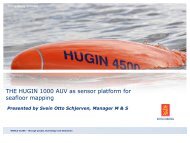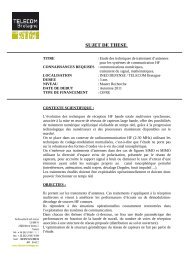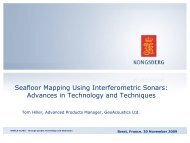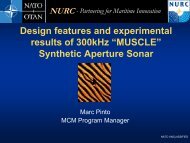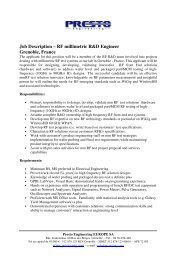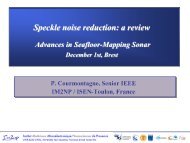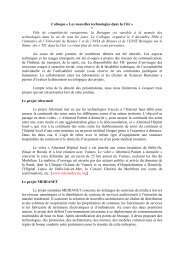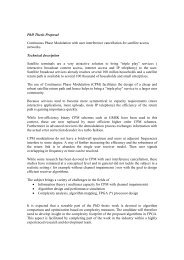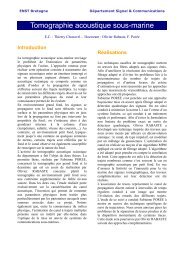Département Réseau, Sécurité et Multimédia Rapport d'Activités 2008
Département Réseau, Sécurité et Multimédia Rapport d'Activités 2008
Département Réseau, Sécurité et Multimédia Rapport d'Activités 2008
Create successful ePaper yourself
Turn your PDF publications into a flip-book with our unique Google optimized e-Paper software.
Optimized mobility management in h<strong>et</strong>erogeneous accessn<strong>et</strong>worksResearch Staff : Nicolas Montavont, Jean-Marie Bonnin, Xavier LagrangePh.D. student: Richard RouilKeywords : h<strong>et</strong>erogeneous access n<strong>et</strong>works, seamless mobility, IEEE 802.21, wireless n<strong>et</strong>worksimulation, NS-2Applications : ITS, transportation systemPartners & Funding : NIST (National Institute of Standards and Technology, USA)IntroductionRealizationThe main objective of this project is the designand the simulation of a unified framework tomanage handover across h<strong>et</strong>erogeneousenvironment. The targ<strong>et</strong> scenario is themanagement of multiple mobile nodes thataccess the Intern<strong>et</strong> through variouscommunication technologies. In this context, itis important for mobile nodes to learn theenvironment characteristics to help flowdistribution over available n<strong>et</strong>workattachments. In this learning process, we needto focus on the delay of handover in order tomake mobility as seamless as possible. Inorder to faster the flow redirection acrossvarious interfaces, we will then develop stronginteraction b<strong>et</strong>ween layers.In addition to the environment discovery, aninformation exchange mechanism among thedifferent nodes in the system need to bedeveloped in order to enhance the globalknowledge of the n<strong>et</strong>work topology on eachnode. This work is then tied to standardizationeffort of IEEE 802.21 that designs mechanismsto enable handover and interoperabilityb<strong>et</strong>ween h<strong>et</strong>erogeneous n<strong>et</strong>work typesincluding both 802 and non 802 n<strong>et</strong>works.The second major topic of this project is thesimulation framework. Research intelecommunication has always relied onsimulation for evaluation purpose. Would it befor deployment of wireless base stations or forthe investigation of corner cases of a particularprotocol, the simulation tool brings animportant evaluation framework to a validationprocess. It is a complementary study ofanalysis performance and it allows focusing ona s<strong>et</strong> of param<strong>et</strong>ers to adjust the specificationof a protocol. In this project several scenariosare simulated to investigate all aspects ofmobility.A new IEEE 802.16 model has been designedfor the n<strong>et</strong>work simulator NS-2 [1]. Thissimulation framework has been adopted by theWiMAX forum as the official IEEE 802.16simulation model. It provides the MAC andPHY layers on both Base Station and MobileStation. We also proposed a s<strong>et</strong> of schedulingalgorithms for the base stations to control slotallocation in the WiMAX system [2].Lately, we focus on the MIH messag<strong>et</strong>ransport. In the standard, the actual transportmechanism is not specified but the MIHmessages can be carried over layer 2, layer 3,or any layer above. The low pack<strong>et</strong> latencyand reliability dictate the selection of th<strong>et</strong>ransport protocol. If the necessary signaling isnot compl<strong>et</strong>ed prior to losing connectivity, themobile node relies solely on local informationand may connect to an invalid n<strong>et</strong>work. Themain reason to trigger a handover is adegredation in signal quality. This also meansthat the connection is suffering from higherpack<strong>et</strong> loss rate. Thus the transport protocolcarrying the MIH messages must be able tomaintain its service under conditions of highpack<strong>et</strong> loss rate. Traditional transportprotocols, namely User Datagram Protocol(UDP) and Transmission Control Protocol (TCP)provide communication b<strong>et</strong>ween two Intern<strong>et</strong>Protocol (IP) addresses and rely on additionalmechanisms such as Mobile IP to handlemobility. This means that the performance ofthese protocols is dependant on the mobilityprotocol located at the n<strong>et</strong>work layer. Incontrast, Stream Control Transport Protocol(SCTP) embeds multihoming andmultistreaming capabilities. The DynamicAddress Reconfiguration also allows SCTP toperform layer 4 handovers. Thus we arestudying the advantages and performances ofthese transport protocols in order to provide acomprehensive analysis. This analysis hasbeen presented at the IETF, in the MIPSHOP26 Extract of Pracom’s Annual Report <strong>2008</strong>



